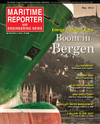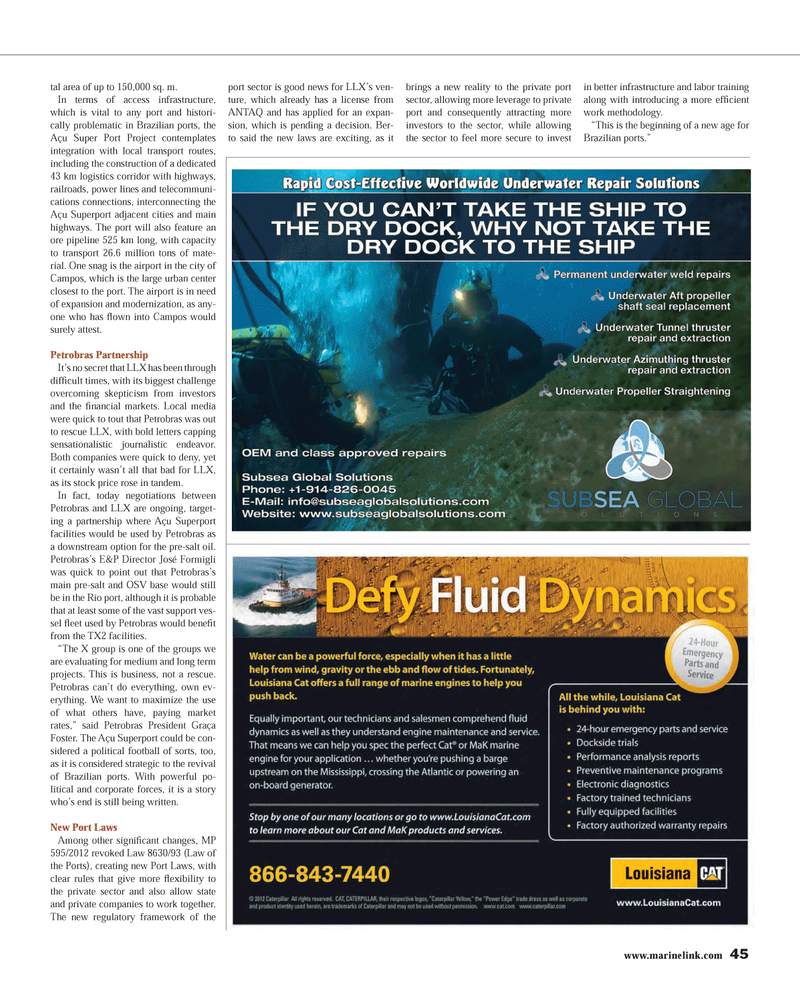
Page 45: of Maritime Reporter Magazine (May 2013)
Energy Production & Transportation
Read this page in Pdf, Flash or Html5 edition of May 2013 Maritime Reporter Magazine
www.marinelink.com 45tal area of up to 150,000 sq. m. In terms of access infrastructure, which is vital to any port and histori-cally problematic in Brazilian ports, the Açu Super Port Project contemplates integration with local transport routes, including the construction of a dedicated 43 km logistics corridor with highways, railroads, power lines and telecommuni-cations connections, interconnecting the Açu Superport adjacent cities and main highways. The port will also feature an ore pipeline 525 km long, with capacity to transport 26.6 million tons of mate-rial. One snag is the airport in the city of Campos, which is the large urban center closest to the port. The airport is in need of expansion and modernization, as any-one who has ß own into Campos would surely attest.Petrobras Partnership It?s no secret that LLX has been through difÞ cult times, with its biggest challenge overcoming skepticism from investors and the Þ nancial markets. Local media were quick to tout that Petrobras was out to rescue LLX, with bold letters capping sensationalistic journalistic endeavor. Both companies were quick to deny, yet it certainly wasn?t all that bad for LLX, as its stock price rose in tandem. In fact, today negotiations between Petrobras and LLX are ongoing, target- ing a partnership where Açu Superport facilities would be used by Petrobras as a downstream option for the pre-salt oil. Petrobras?s E&P Director José Formigli was quick to point out that Petrobras?s main pre-salt and OSV base would still be in the Rio port, although it is probable that at least some of the vast support ves-sel ß eet used by Petrobras would bene Þ t from the TX2 facilities. ?The X group is one of the groups we are evaluating for medium and long term projects. This is business, not a rescue. Petrobras can?t do everything, own ev- erything. We want to maximize the use of what others have, paying market rates,? said Petrobras President Graça Foster. The Açu Superport could be con- sidered a political football of sorts, too, as it is considered strategic to the revival of Brazilian ports. With powerful po- litical and corporate forces, it is a story who?s end is still being written. New Port LawsAmong other signiÞ cant changes, MP 595/2012 revoked Law 8630/93 (Law of the Ports), creating new Port Laws, with clear rules that give more ß exibility to the private sector and also allow state and private companies to work together. The new regulatory framework of the port sector is good news for LLX?s ven- ture, which already has a license from ANTAQ and has applied for an expan- sion, which is pending a decision. Ber- to said the new laws are exciting, as it brings a new reality to the private port sector, allowing more leverage to private port and consequently attracting more investors to the sector, while allowing the sector to feel more secure to invest in better infrastructure and labor training along with introducing a more efÞ cient work methodology. ?This is the beginning of a new age for Brazilian ports.?MR #5 (42-49).indd 45MR #5 (42-49).indd 455/2/2013 3:26:12 PM5/2/2013 3:26:12 PM

 44
44

 46
46
